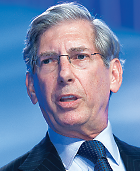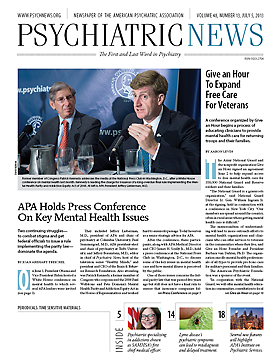The way that psychiatric medicine is practiced in this country—as well as the way mental health care is delivered and financed—is about to change dramatically. The president and Congress are the key drivers in this process, and the critical question everyone’s asking is this: “Will the government do the right thing?”
This is a broad question that many have asked about health care issues for years—as we struggle to improve health care and make it more accessible and cost-effective. But it’s especially important now, as we await the final rule on the Mental Health Parity and Addiction Equity Act, which was passed in 2008 but has yet to be fully implemented. The detailed final rule—which nobody has yet seen but is due out soon—will determine precisely how the law’s provisions will be implemented. Until then, we continue to have symbolic but not actual parity.
As if this were not enough, we also are in the early stages of health care reform via the Patient Protection and Affordable Care Act.
Because so much currently hangs in the political balance for psychiatrists and APA, when I was invited to a special White House Conference on Mental Health last month, I immediately cleared my schedule, as did my invited APA colleagues Paul Summergrad (president-elect) and Jeff Borenstein (chair of the Council on Communications and editor in chief of Psychiatric News).
The daylong event was held June 3 in the West Wing of the White House and featured an impressive assemblage of passionate presenters, starting with President Obama (whose moving speech set the tone for the day) and ending with Vice President Joe Biden (whose rousing call to arms concluded the meeting). In between we heard from Health and Human Services Secretary Sebelius (whose department must issue the final parity rule), Education Secretary Arne Duncan, and Veterans Affairs Secretary Eric Shinseki. Also in attendance were a broad assortment of senators and members of Congress including former Congressman Patrick Kennedy (now a consultant to APA), representatives from the NIH, SAMHSA, and other professional organizations (including the AMA and the American Psychological Association), notable authors Kay Jamison and Elyn Saks, as well as representatives from numerous consumer and advocacy organizations. Two of our best-known actor/advocates also spoke: Glenn Close (whose sister has schizoaffective disorder, prompting the two of them to found the BringChange2Mind antistigma initiative) and Brad Cooper (who played the lead character, with bipolar disorder, in the feature film “Silver Linings Playbook”).The invitees represented amazingly diverse constituencies and backgrounds, but were joined by a common interest: to improve the lives of people with mental illness by enhancing the quality of care and access to it.
It was an exciting day at the White House for all of us—inspiring, encouraging, and challenging. It was also, in the language of diplomatic speak, a day full of “informative discussions” and the “frank exchanges of ideas.” And while I left feeling elated, I was equally concerned.
Don’t get me wrong: the conference represented, to my mind, the most important and significant presidential effort on behalf of mental health care since Rosalynn Carter’s White House Conference on Mental Illness over 30 years ago. But there were things about it that gave me pause. The tenor and content of the meeting were not as medically oriented or scientifically based as I would have liked. The presentations and discussions got a little too “touchy feely” at times, and the overall focus seemed more on social-science approaches to mental health care than biomedical or neuroscience perspectives. This is not to say that recovery, peer support, counseling, and stigma are not vitally important issues for the enhancement of mental health care quality and access. But health care begins with accurate medical diagnosis and gold-standard treatment—and the whole point of the Mental Health Parity and Addiction Equity Act is to make sure that patients get both medical treatment and supportive services from professionals and peers. I seriously doubt that a daylong government call to arms on other public health problems such as cancer, cardiovascular disease, or infectious disease would have devoted so little time to talking about medical approaches and their scientific underpinnings. I would have liked to hear more about collaborative care models, early detection and intervention strategies, methods of treating medical and substance use comorbidity in people with mental disorders, and the need for more research ranging from translational neuroscience to comparative effectiveness studies.
As we left the conference and walked down the White House driveway, we felt exhilarated and optimistic. But we also wondered aloud what the government’s next steps would be and whether they would measure up to the importance and urgency of this critical issue. We hadno question about the sincerity of the administration, but worried whether it had the political “bandwidth” and will to actively engage in an ambitious effort on mental health. After all, the way we were brought together, rather hurriedly, led some to expect a major policy announcement—either about the final rule on mental health parity or a new government initiative. Instead, we got more of a series of brilliant and high-powered pep talks, encouragement without enough real promises of action.
Nonetheless, I am going to take this White House conference as a very positive first step, one we need to encourage and help turn into ambitious action. I am also going to remain hopeful about the final mental health parity rule. At the same time, APA needs to monitor developments and be prepared to be proactive if they falter or come up short. APA’s Department of Government Relations and our other relevant staff and elected or appointed leaders stand ready to inform and influence the political process. If we want the government to “do the right thing,” we need to help the government understand what the right thing is and realize that the President and Congress can’t do this alone. We, too, have to “do the right thing” for our patients and our profession. We must come to the table willing to demand parity and an end to stigma, but we must also be active partners in improving quality and efficiency of care. ■

